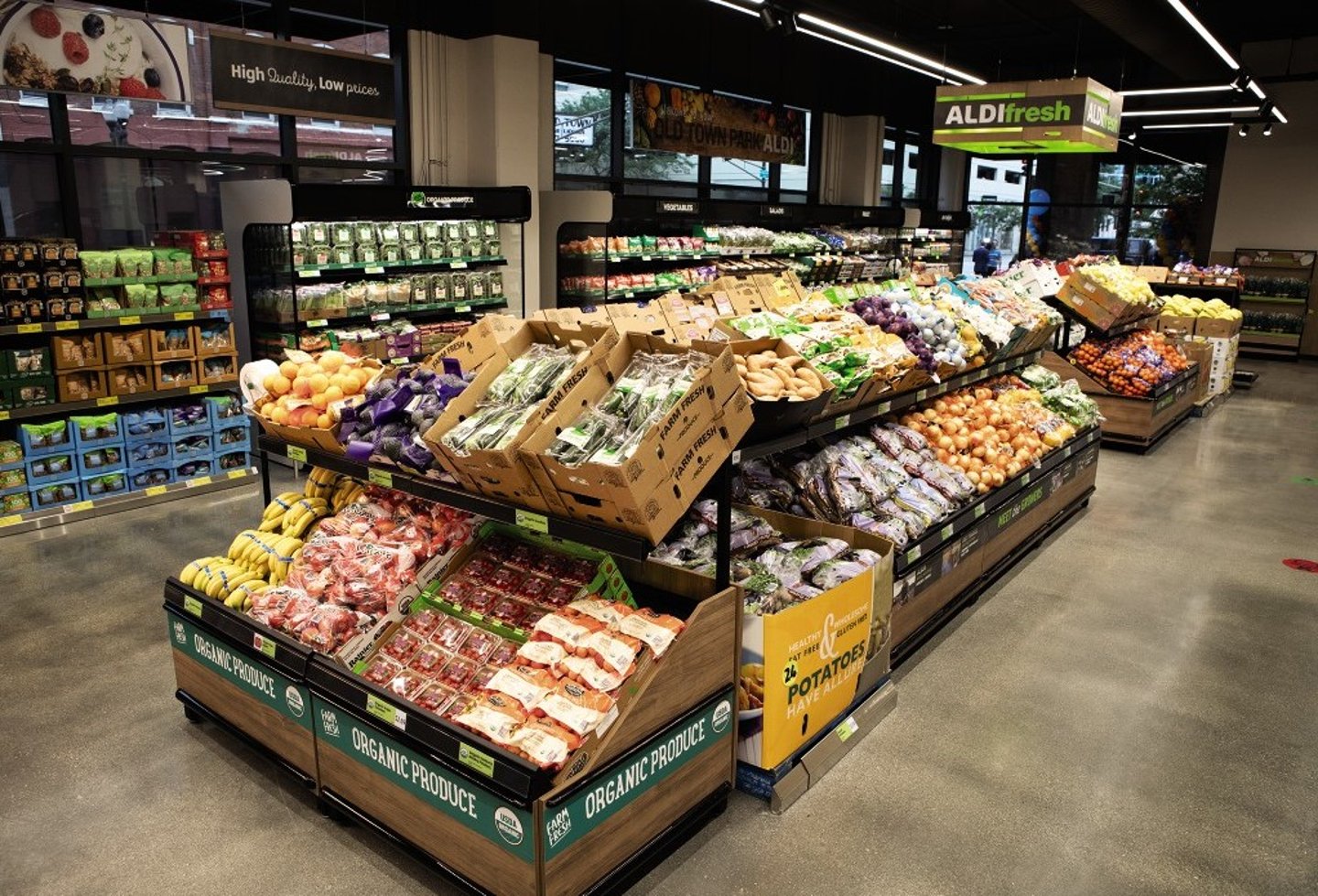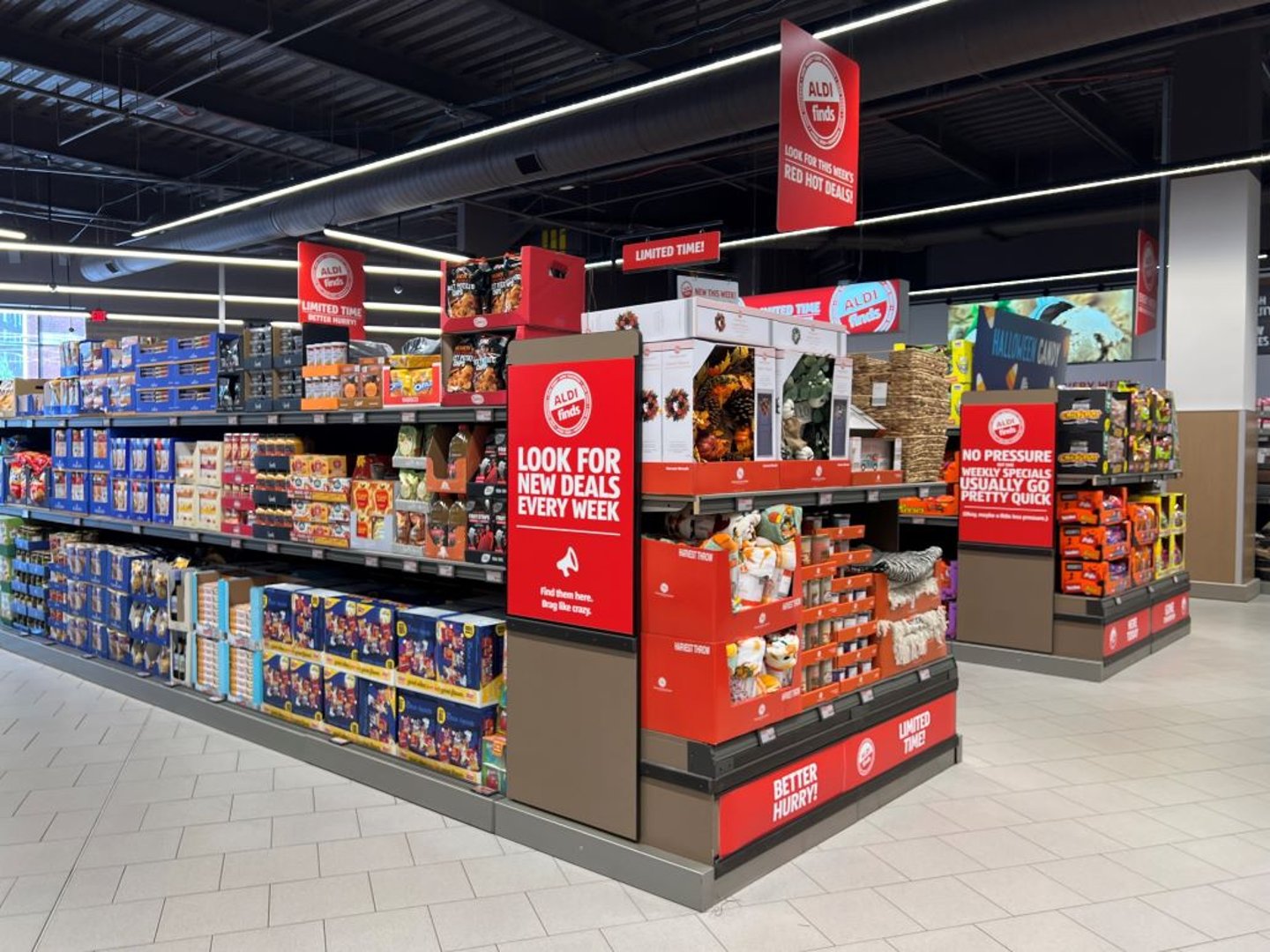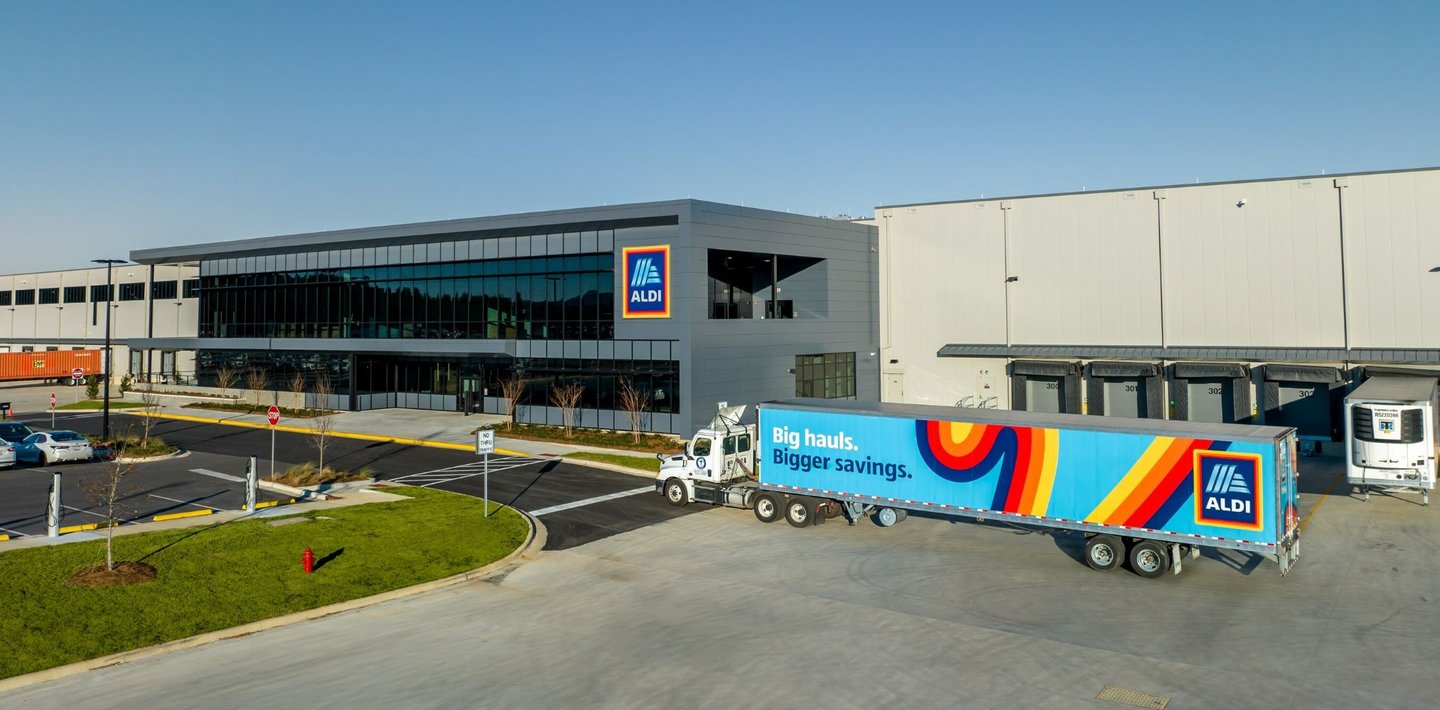Exploring ALDI's Unlimited Success With Limited Assortments
U.S. shoppers are head over heels in love with ALDI — literally.
In November, Michael Hurd and Jessica Bojanowski got married in the produce section of the company’s U.S. flagship location, in Batavia, Ill., after spending many months “dating” by shopping together at ALDI.
“We still have our weekly shopping ‘dates’ at ALDI every Sunday, and every time we walk in that door, we are reminded of our wedding day,” the happy couple told People magazine in January. “Our love for each other and our ALDI obsession has grown tenfold since that beautiful November day.”
[Read more: "Why Aldi Is at the Sweet Spot of Food Retailing"]
Michael and Jessica will soon have to share that obsession with a lot more shoppers.
In October, the German-owned discount grocer, which first put down roots in the United States back in 1976, revealed that more than 1 million new shoppers had lifted same-store sales growth by double digits year over year at the chain, as inflation drives consumers to look for bargains on food. In January, the company with estimated annual sales of $19 billion unveiled its 26th distribution center, which will supercharge the retailer’s expansion in the fast-growing Sun Belt. That same month, dunnhumby named ALDI the No. 1 grocery leader in Price for the sixth year in a row.
In an exclusive interview with Progressive Grocer, Scott Patton, ALDI’s VP of national buying, says the ALDI business model was built for these inflationary times.
“Our greatest opportunity is introducing ALDI to new shoppers at a time when consumers need a tangible solution to the inflationary pressures they are feeling from every direction,” Patton notes. “Offering access to fresh foods and essential household products at incredible prices, like we have been doing for decades, is more important now than ever before. We look forward to welcoming even more new customers and earning their loyalty.”
Of course, discount stores tend to perform well during times of economic pain and uncertainty, but ALDI has weathered the pandemic storm particularly well by expanding its assortment of fresh food, ramping up its digital offering, remodeling stores, curating assortments with local products and accelerating sustainability efforts – all while strictly adhering to its EDLP pricing philosophy.
Fastest-Growing Grocer
In 2017, ALDI said that it would invest $3.4 billion to accelerate store openings, with a goal of growing from 1,700 locations to a 2,500-store footprint by 2022. But the pandemic put a kink in that plan in 2020, with many of those planned openings taking a backseat to getting product on shelves and expanding contactless fulfillment options for shoppers too scared to enter physical locations.
So where does that evolution stand now?
“It is no secret that the pandemic created shifts in consumer shopping habits, and more specifically, how people shop,” Patton says. “But our efficient business model allows us to react in real time to meet consumer needs and preferences.”
Part of that quick reaction includes leading the United States in new store openings. In early 2022, the discount grocer revealed plans to open 150 new stores by the end of the year. While the retailer was able to open and remodel 139 locations last year, that’s still more new openings than any other grocer in the country, according to a new report from JLL, a Chicago-based professional services firm. ALDI is now the third-largest grocer in the United States by store count, with a current total of 2,285 stores.
ALDI currently has its sights set on establishing a dominant presence in the Sun Belt, a swath of the United States that has attracted scores of new residents since the pandemic. Last month, the retailer opened another regional headquarters and distribution center, in Loxley, Ala., which will ultimately serve as many as 100 stores across the Gulf Coast. Historically, ALDI distribution centers have been designed to service 70 to 75 stores in a 150-to-200-mile radius.
“At a time when inflation is putting pressure on American wallets, we believe our mission to save people money on the food and products they need is more important than ever,” says Heather Moore, ALDI divisional VP for the Loxley region. “We are thrilled to see so much customer love for the 20 stores we’ve opened in the Gulf Coast area in the last year alone. Once they see the quality, selection and value ALDI offers, they keep coming back. That’s why we’re committed to providing our customers the lowest possible price and the best possible value — that’s something that will never change.”
The 564,000-square-foot Loxley facility (most ALDI DCs range between 400,000 to 525,000 square feet) is equipped to service stores across Louisiana, Alabama, Mississippi and the Florida Panhandle. In total, the 100 stores that will be supported by the Loxley facility represent an opportunity to reach more than 8 million customers.
As the company's sixth regional headquarters in the southern United States, Loxley aims to support the grocer’s rapid expansion in the region. ALDI is now operating 30 stores in the Gulf Coast, having opened 20 stores in the area in the past year alone. It plans to add another 13 stores in 2023, including one in Fairhope, Ala., that is slated to open on March 2. Other stores in development include locations in Tampa and Callaway, Fla.; Flowood and Hattiesburg, Miss.; and in the Baton Rouge, La., area.
Driving all of this growth is a fervent customer base: A new report from Los Altos, Calif.-based Placer.ai shows that ALDI saw some of the greatest gains in foot traffic during the fourth quarter of 2022. Specifically, the grocer saw store traffic increase 6.8% YoY and 30.2% Yo3Y – in large part thanks to the brand’s ongoing U.S. expansion.
“Within grocery, there are two subcategories that generally overperformed in 2022: those that serve as a primary one-stop shop for the bulk of grocery needs, and those with a value orientation,” explains Ethan Chernofsky, VP of marketing for Placer.ai. “The latter segment also benefited from the massive expansions in overall footprint for some of the leaders within that group. Even as the impact of inflation dissipates, there is ample reason to expect both of these groups to continue to show strength.”
The other part of ALDI’s value proposition for shoppers comes from the design of its smaller, easier-to-shop stores.
“At ALDI, we offer a store experience that is fast, efficient and fun,” notes Joan Kavanaugh, VP of national buying at ALDI. “A typical store is approximately 12,000 square feet of retail space, making ALDI stores easier and quicker to navigate. Every ALDI has a similar easy-to-shop layout, so it feels familiar to customers no matter where in the country they’re shopping.”
According to Kavanaugh, the company is working to make the shopping experience “even more convenient by remodeling stores in select markets to include self-checkout lanes.
“So far, the customer reaction has been extremely positive, and shoppers are excited about the added option for quick shopping trips,” she adds.
Omnichannel Discounter
When the pandemic hit, ALDI was ready for the grocery e-commerce boom.
The retailer had already partnered up with Instacart in 2018 on delivery, so it was well prepared to offer e-commerce options when shoppers drastically cut back on trips to its physical locations.
In 2020, ALDI was the first grocery retailer to work with San Francisco-based Instacart on launching and then expanding shopper access to the Electronic Benefit Transfer and Supplemental Nutrition Assistance Program (EBT SNAP). As part of this program, EBT SNAP participants were able to shop from ALDI via the Instacart online site and mobile app at a critically important time: the peak of the pandemic.
“We pivoted to accelerate our e-commerce operations to give our customers more ways to access fresh groceries and essential household items,” Patton says. “This included investments in services like curbside grocery pickup and grocery delivery. Since the world has opened back up, the shift to e-commerce has not slowed and we are seeing shoppers continue to use these options as a convenient way to shop with.”
Recently, ALDI has moved to invest further in its omni operations. The retailer has been working with Spryker, a German technology company, to develop a new online food and grocery shopping experience for the U.S. market, offering grocery delivery or curbside pickup. The new digital commerce platform is currently being tested with a select group of U.S. shoppers and is planned to be introduced nationally in a phased approach.
ALDI’s new digital commerce platform follows through on the grocer’s pledge made last year to increase access to convenient online shopping options. During that time, ALDI indicated that it would expand its curbside grocery pickup offering from 1,200 to 1,500 stores by the end of the year.
“Our partnership with Spryker will allow our shoppers another way to access the incredible value they expect from ALDI,” Patton says.
Trip Consolidator Destination
One of the many repercussions of inflation and elevated fuel prices during the past year has been trip consolidation: Consumers are shopping fewer stores, trying to get everything they need in one shop. They simply don’t want to burn gas driving to multiple stores, or to stores too far from their homes.
“The impact of inflation and other economic headwinds are likely to continue affecting consumers in the coming months,” Placer.ai’s Chernofsky says. “While a degree of continued ‘trading down’ is to be expected, another important effect has been the lengthening of visit duration driving greater opportunity for those chains that succeed in driving the visits. This understanding is going to be critical for chains to best position themselves for an extended period where the effects of continued economic headwinds are felt.”
Trip consolidation has been a bon for ALDI, which fine-tunes its assortment to provide a perfect mix of 90% private label and 10% branded products that are on-trend, local and seasonal, with a little treasure hunt mixed in.
“We do things differently at ALDI by design,” Patton asserts. “We’re passionate about offering ALDI shoppers fresh and delicious foods, and on-trend products we know they’ll love, always at great prices. Customers can always shop with confidence because one in three of our ALDI-exclusive products are award-winning, and we back that up with our Twice as Nice Guarantee.”
As sales of natural food products continue to rise as a result of post-pandemic-related health concerns, ALDI is doubling down on better-for-you, organics and non-GMO.
ALDI-exclusive brand Simply Nature offers customers many organic options at affordable prices. All Simply Nature foods are certified organic or Non-GMO Project Verified, and meet USDA National Organic Program Standards. On top of that, nearly 100 Simply Nature foods have earned the Good Housekeeping Nutritionist Approved Emblem.
ALDI is also focused on making sure that assortments reflect local communities.
“What makes shopping at ALDI fast and easy is the consistent experience and product assortment in our stores from coast to coast,” Patton says. “That said, we know preferences vary across the country, which is why about 5%-10% of the products in each store are regional items. Shoppers are likely to find their favorite local brands, craft beers, and various types of breads or cuts of meat that are particularly popular in the area.”
The discounter also offers rotating seasonal items and flavors, and its treasure-hunt program, ALDI Finds. These limited-time specialty items range from unique foods and home goods to other unexpected items like workout equipment, furniture or décor.
“We make sure to offer our shoppers the items they need during that time of year,” Patton explains. “If you visit ALDI over the summer, you may find grilling essentials, and during the holidays, we will have shelves dedicated to meats and cheeses for charcuterie boards, and kitchen items needed for hosting.”
ALDI has also attributed some of its success to offering more fresh produce over the past two years; in fact, produce now makes up two-thirds of what ALDI customers put into their carts.
Lean and Green
As ALDI continues its rapid expansion across the United States, and as consumers increasingly shop with sustainability concerns in mind, the retailer remains committed to becoming a more eco-friendly company.
For instance, the new DC in Alabama features some of the most innovative and efficient design components included in any ALDI facility to date, including roof-mounted solar panels, LED lighting, an environmentally friendly refrigeration system and metal panel insulation. These elements work together to create a thermally tight and efficient building.
The retailer has also remodeled more than 1,100 existing stores to be more eco-friendly, and has invested more than $5 billion to support making new and remodeled stores more environmentally friendly.
“Sustainability has always been a driving force at ALDI, and we’re proud that the ALDI model is inherently more sustainable,” Kavanaugh affirms. “Our commitment to reduce greenhouse-gas emissions by 26% in 2025 can be seen throughout many of our new and remodeled stores, which may feature environmentally friendly building supplies, energy-efficient HVAC units, more environmentally friendly refrigerants, and/or solar panels.”
Last year, ALDI released its first-ever “Corporate Responsibility Progress Report,” which outlined progress toward its environmental goals. Also, the grocer is working to reduce its use of plastic and increase the recyclability of its packaging. To date, 62% of ALDI-exclusive packaging is reusable, recyclable or compostable. The company additionally plans to eliminate all plastic shopping bags from stores by the end of 2023 and to reduce operational food waste, all while ensuring that its products are responsibly sourced and remain affordable. It’s a value proposition that’s helping ALDI outperform competitors and grab greater market share as more shoppers seek quality products and relief from inflationary prices.
As Patton notes, “Our business is built on maximizing cost savings that we pass along to our customers — an approach that we have been practicing since we opened our first store, and one that is more important than ever before.”







